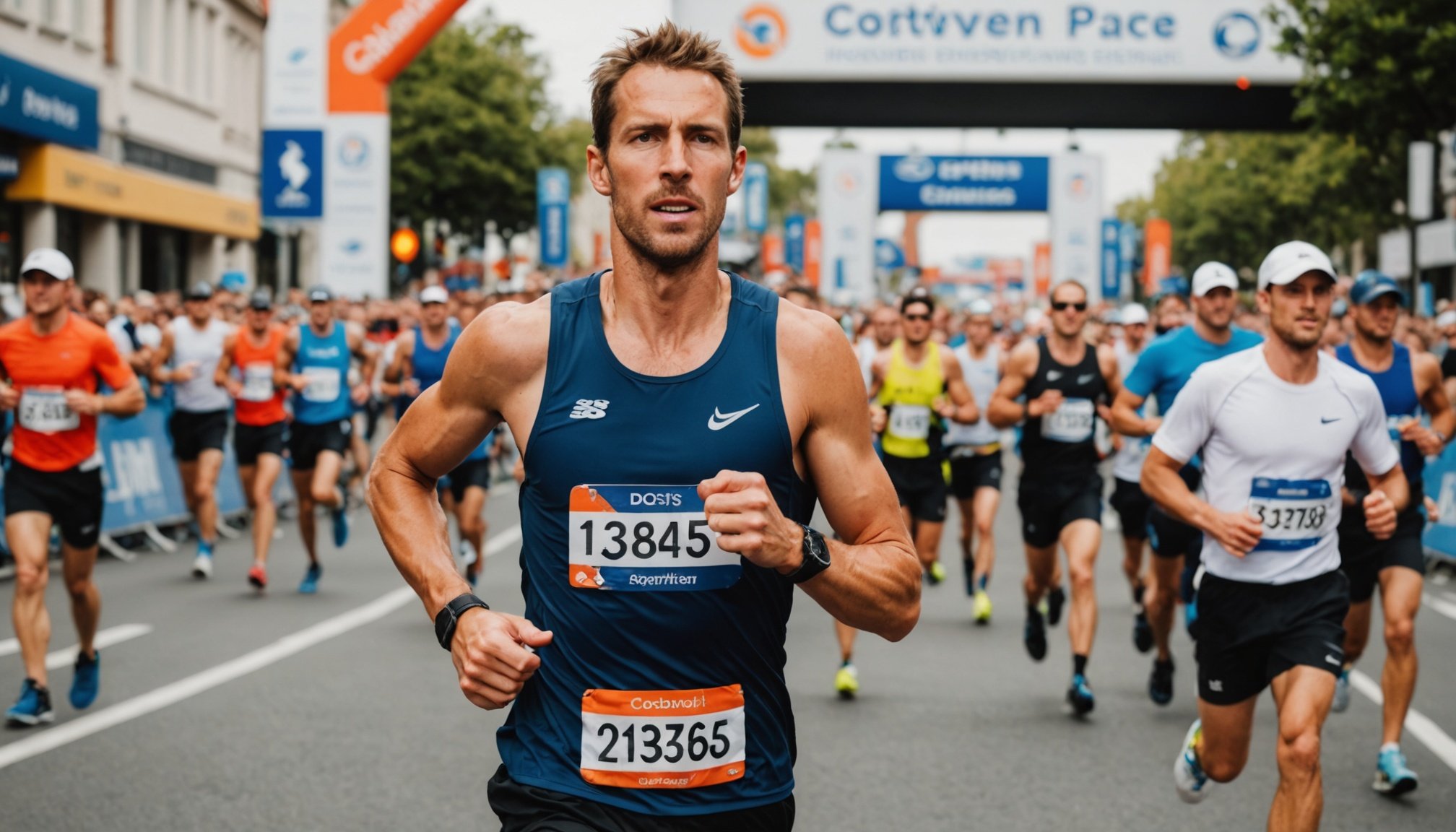Understanding Marathon Pace
Marathon pacing is a critical component of a runner’s strategy, significantly impacting their overall performance. Marathon pacing strategies are essential for maintaining a steady and sustainable speed throughout the 26.2-mile race. This approach prevents early fatigue and ensures that energy reserves last until the finish line.
The term “marathon pace” defines the speed at which a runner aims to maintain for the duration of the race, balancing speed and endurance. Selecting an optimal race pace requires understanding individual fitness levels, training adaptations, and personal goals. A strategic choice in pacing helps manage energy expenditure efficiently, using glycogen and fat stores effectively to delay the onset of fatigue.
Also to read : Empower your dance: the ultimate safe and effective strength training guide for dancers
Physiological factors like aerobic capacity, energy management, and muscle endurance play crucial roles in determining how well a runner can stick to their established pacing plan. For instance, higher aerobic capacity can mean a more sustainable speed over long distances. Monitoring and adjusting pace ensures alignment with the body’s cues, conserving energy for later stages when it is crucially needed.
Incorporating these methods into training sessions helps runners focus on achieving their personal best. Understanding and mastering the complexities of marathon pacing can significantly influence the final outcome, allowing for an optimised performance that maximises potential on race day.
This might interest you : Elevate your golf performance: the definitive strength training blueprint for hitting longer drives
Techniques for Pacing Strategy
To enhance your race day strategies, understanding differing pacing techniques is crucial. One approach to consider is negative splits, where you gradually increase your pace during the race. This tactic often leads to better performance, as starting conservatively allows you to conserve energy for a strong finish. Conversely, positive splits involve starting fast and slowing down, which can be beneficial in short races but risky for longer distances due to early energy depletion.
Consistent pacing is another vital element, as it helps maintain stamina throughout the race. The steadiness reduces the risk of burnout and ensures you are energy-efficient from start to finish. Implementing energy control methods such as a steady pace can significantly impact your overall performance and avoid unnecessary fatigue.
The use of technology and apps has revolutionised race day pacing. There are tools available that provide real-time feedback on pacing techniques, enabling runners to adjust their strategy mid-race. These apps can monitor heart rate and distance, providing data to fine-tune your energy control methods. Leveraging such technology can be a game-changer, ensuring your race tactics are informed and effective.
Energy Management for Endurance
When it comes to maintaining optimal endurance performance during long-distance events like marathons, mastering energy optimization is crucial. Effective fueling strategies are the cornerstone of energy management. Before the marathon, it’s important to consume a balanced meal rich in carbohydrates, proteins, and healthy fats to provide sustained energy. During the race, regular intake of energy gels or bars can help replenish glycogen levels, keeping fatigue at bay.
Hydration plays an equally vital role in managing energy. Start by finding the right balance between not drinking enough and overhydrating. Aim to consume fluids before feeling thirsty, using a combination of water and electrolyte solutions to maintain proper hydration levels. This practice not only aids in energy optimization but also prevents cramps and heat-related issues.
Recognizing signs of fatigue is crucial to adjust the pace and prevent energy depletion. Monitor your body’s cues, such as heavy breathing or muscle fatigue, and respond by slowing down or taking brief walking breaks. By listening to your body and managing energy levels efficiently, you can improve endurance performance and increase the likelihood of finishing strong. Embrace these strategies, and enjoy a more successful marathon experience.
Pre-Race Preparation
Ensuring peak performance on race day requires meticulous steps, one of which is following a structured marathon training plan. A critical component of this is tapering, a period where training intensity gradually decreases to allow physical recovery while maintaining fitness levels. This process significantly impacts performance by reducing fatigue and increasing muscle strength, providing the advantage of starting the race fresh and energized.
For many runners, the very thought of race day brings about anxiety. Implementing mental strategies can be extremely beneficial in managing this apprehensiveness. Visualisation techniques, where runners envision themselves successfully completing the marathon, can instill confidence. Additionally, relaxation practices like deep breathing are simple yet effective in maintaining focus and reducing stress.
Incorporating practice races into the training regimen serves as an excellent opportunity to fine-tune pacing and energy management. Simulating race conditions helps runners understand how to conserve energy and apply it strategically throughout different parts of the marathon. This experience aids in recognising personal signals of fatigue and adjusting pace accordingly.
By committing to these preparatory steps with dedication and consistency, runners can enhance their readiness and enter the race with assurance.
Training Methods for Optimal Performance
Enhancing marathon performance requires a multifaceted approach to endurance training. One essential method is incorporating both long runs and tempo runs into your routine. Long runs build the foundational endurance necessary for marathons, while tempo runs improve pace by challenging the aerobic threshold.
Pace variability is crucial in this context. By adjusting your speed during these runs, you enable your body to adapt to the fluctuating demands of a marathon. This aspect becomes particularly significant during interval training, which is another vital component for elevating marathon pace. Through sprinting bursts interspersed with slower recovery segments, interval training effectively boosts cardiovascular endurance and muscular efficiency.
In addition to classic running workouts, cross-training is invaluable for maintaining peak performance. Activities such as cycling or swimming offer low-impact alternatives that aid in energy conservation while still enhancing cardiovascular fitness. Cross-training prevents injury by reducing repetitive strain associated with continuous running, providing holistic benefits for runners.
Furthermore, integrating strength training for runners strengthens muscle groups essential for maintaining form and stamina over long distances, ensuring a more resilient physique capable of tackling the rigours of marathon running. Incorporating exercises targeting the core, legs, and glutes can significantly enhance running efficiency and endurance.
Real-Life Examples and Expert Insights
Understanding the elements that contribute to marathon success can be both fascinating and enlightening. Marathon success stories often highlight how runners use specific pacing strategies to achieve their goals. For instance, many runners adopt a negative split strategy — where they run the second half of the race faster than the first. This approach has been successful for numerous elite athletes, as it helps manage energy levels and avoid burnout.
To deepen our understanding, we turn to expert testimonials from seasoned coaches. Many experts advocate for a tailored pacing plan that accounts for individual strengths and weaknesses. This includes strategic use of speedwork and endurance training in the preparatory phase, ensuring that runners can maintain an optimal pace throughout different sections of the marathon.
In addition, performance analysis of marathon data provides valuable insights into pacing effectiveness. Analysis has shown that consistent pacing often correlates with faster finishing times. By studying these patterns, both amateur and professional athletes can fine-tune their strategies. Such insights highlight the importance of a strategic approach to pacing in achieving marathon success.
Visual Tools and Resources
To optimise your pre-race strategy, utilising pacing charts can be incredibly beneficial. These charts allow athletes to plan their race with precision by breaking down the pacing required to achieve specific timings. By setting clear goals, pacing charts aid in maintaining desired speed, providing a clear reference throughout the run.
For those in training, performance tracking can be significantly enhanced through various online tools and apps. These resources help in monitoring progress, offering insights into pace trends and improvements over time. Tracking training performance not only boosts motivation but also aids in making informed decisions about when to push harder or rest.
Moreover, sharing access to training resources is crucial for deepening understanding of pacing and energy management. Numerous platforms offer articles and guides on effective pacing strategies, allowing athletes to learn and implement new techniques. These resources are designed to empower runners with knowledge and access to proven strategies that facilitate improved performance.
Ensuring that your approach to both training and racing is well-informed can lead to marked improvements, making the use of pacing charts and performance tracking indispensable.











